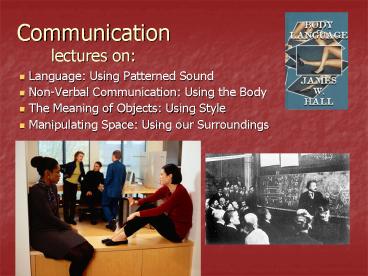Communication lectures on: - PowerPoint PPT Presentation
1 / 23
Title:
Communication lectures on:
Description:
ouche (Fr) from olca (Celtic) from oc* (Indo-European) ... Nixon's V and Bush's hook em' are interesting non-verbal (but not cross-cultural! ... – PowerPoint PPT presentation
Number of Views:169
Avg rating:3.0/5.0
Title: Communication lectures on:
1
Communicationlectures on
- Language Using Patterned Sound
- Non-Verbal Communication Using the Body
- The Meaning of Objects Using Style
- Manipulating Space Using our Surroundings
2
Language and Society
- Language
- Distinguished from a call system by the use of
arbitrary symbols - Arbitrary symbols are culturally agreed-upon
meanings for sounds that are not like the thing
they describe - Non-human chimps cannot speak but can communicate
(as does Koko, with American Sign Language)
3
Language Origins
- Have long been debated
- Due to languages characteristics (it is
performative and ephemeral, like dance) and the
difficulty of connecting language with durable
physical characteristics (except for the hyoid
bone) a definitive answer is unlikely
4
- What is clear is that the activities of our human
ancestors, at least since H. erectus times, would
have required some sort of sophisticated
communication system to indicate abstract
concepts such as time, distance, longing, intent,
etc
5
Language History
- (of the more recent sort) is considerably easier.
- Termed historical linguistics, the relationships
between languages can be discerned through
comparison. - Glottochronology studies the rate of linguistic
change to derive approximate dates for when
languages split from one another (e.g., Latin
into French, Spanish, Italian)
6
(No Transcript)
7
Latin English German French
8
(No Transcript)
9
Language Change
- occurs all the time
- slang,
- regional dialects,
- borrowing from other languages
- an example of English language change is
Chaucers fourteenth century English Canterbury
Tales
10
The Canterbury Tales1347-1400
- Whan that Aprill, with his shoures soote
- The droghte of March hath perced to the roote
- And bathed every veyne in swich licour,
- Of which vertu engendred is the flour
- Whan Zephirus eek with his sweete breeth
- Inspired hath in every holt and heeth
- The tendre croppes, and the yonge sonne
- Hath in the Ram his halfe cours yronne,
- And smale foweles maken melodye,
- That slepen al the nyght with open eye
- So priketh hem Nature in hir corages
- Thanne longen folk to goon on pilgrimages
11
Slangcan you date these?
- Im down with that.
- Cool.
- Twenty-three skidoo.
- Awesome.
- Bad.
- Whatever.
- Dig?
- Groovy.
- Sweet.
- Hidey-ho!
12
The Most Highly Conserved Words in All Languages
are
- I/me, you, two, who, language, name, eye, heart,
tooth, no/not, fingernail/toenail, louse/nit,
water, tear(drop), death, hand, night, blood,
horn (animal), full, sun, ear, salt.
13
An Example of Conservationand Loss
- ouche (Fr) from olca (Celtic) from oc
(Indo-European) - terre de bonne qualite --a good parcel of land
near a dwelling for overflow gardening and
keeping small or sick animals - read about ouches on the class website in the
article From Garden to Globe under Handouts
14
Transmitting Identity across Generations
- transmitted in large part by language
- people let their language stand for much else in
their culture - language, dialect, accent, and speech are always
political and have power - think about the importance of
- speakers language choice among potentially
usable languages - the power of an accent to telegraph to the
listener the speakers class, gender,
ethnicity, etc
15
Sapir-Whorf Hypothesis
- is that language predisposes people to see the
world in a certain way and guides their thinking
and behavior - For example, sustainable in English
characterizes a renewable resource like
well-managed agricultural land or wind power - First used by scholarly, then business community
- But sustentable from Fr. sustenter (support) is
not understood. - Instead durable, (hardy, lasting) or
lentretien du paysage (land management) is used - Used by agricultural community
16
Faux Amis
- A foreign word that looks deceptively like a word
in ones own language - preservatif, je suis pleine examples
- Note gesture in photos
17
Code Switchingan example at the dialectical level
- the smooth movement a person makes from one
dialect to another in different circumstances - includes grammar and syntax, word choice, tone,
volume, gendered speech differences, etc - roof (rooof ruf), tomato, orange
- NC dialectical differences Kerrville
(Cur-ville) but Carr Mill and Kerr Drugs and
Kerr Lake Carolinian pronounced Caroleenian
18
Male/Female Communication
- Studies show that, in general,
- women ask questions, keep the conversation going
with verbal and non-verbal responses, and protest
using silence - men interrupt more, challenge more, more direct
declarations of fact and opinion
19
Phoneme
- A minimally distinct sound in the context of a
particular spoken language - For example, in American English /p/ and /b/ are
distinct phonemes because pat and bat are
distinct however, the two different sounds of
/t/ in tick and stick are not distinct in
English, even though they are distinct in other
languages such as Thai.
20
Morpheme
- The smallest contrastive unit of grammar.
- A minimally distinctive unit of meaning in the
context of a particular language. - For example, cats consists of two morphemes cat
and -s, the plural suffix. The -s is called a
bound form while cat is a free (or stand alone)
form. dogs also has the -s but it is pronounced
/z/.
21
Phonetics and Phonology
- Phonetics is the study of the production,
transmission, and reception of speech sounds - Phonology is the study of rules (grammar)
22
Signals
- Signal a gesture with (culturally) self-evident
meaning. Silent non-verbal communication by
signals or signs - Examples "He signaled his disapproval with a
dismissive hand gesture" "The diner signaled the
waiter to bring the bill"
23
Symbols
- Symbol stands for something else. Nixons V
and Bushs hook em are interesting non-verbal
(but not cross-cultural!) examples, but all
language is symbolic






























